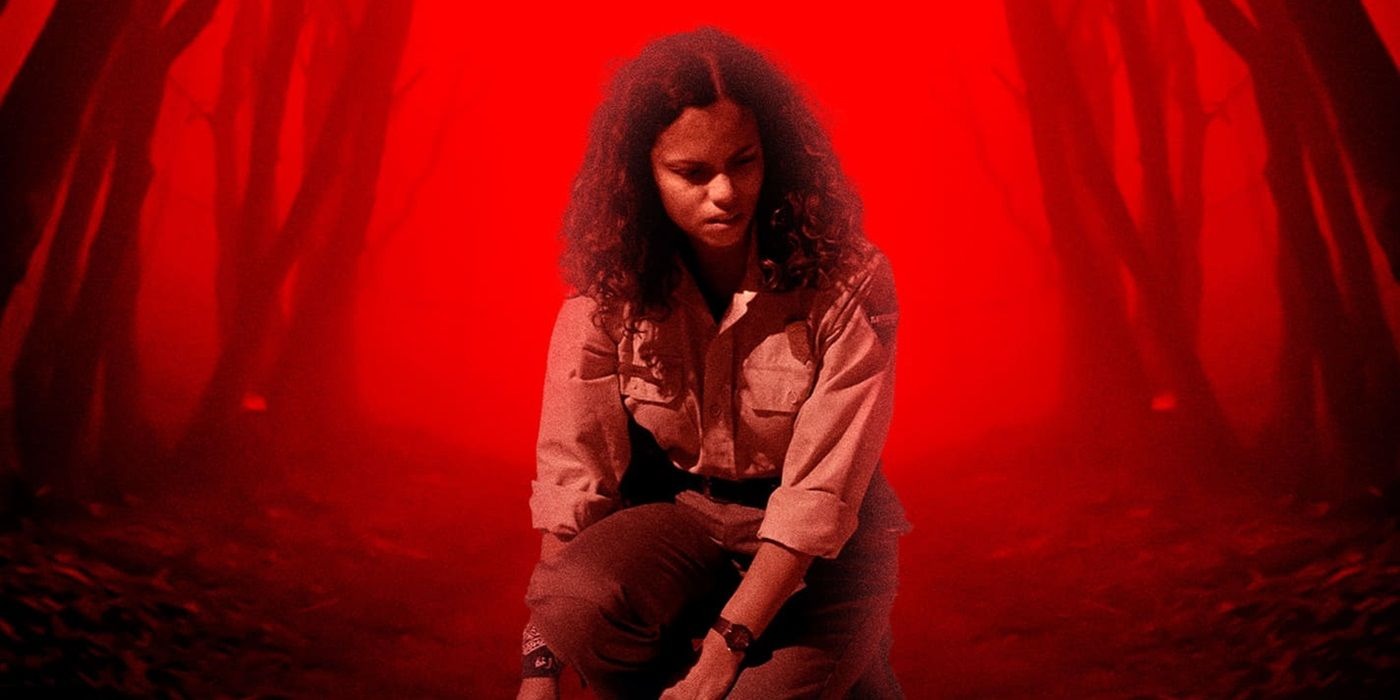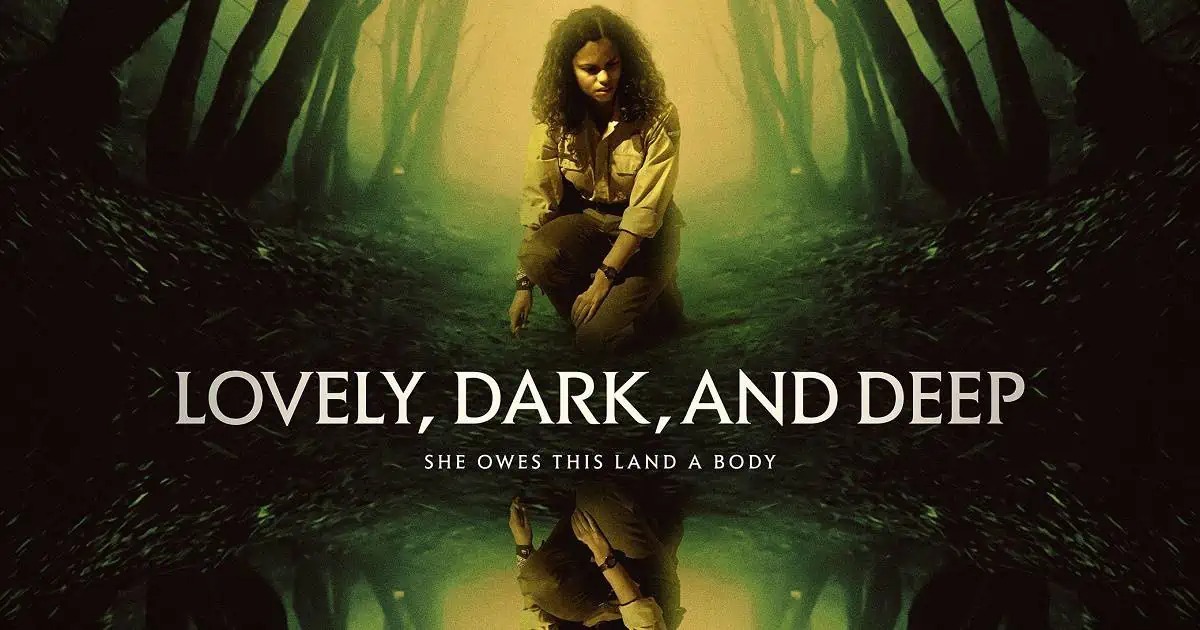Lennon just resumed a fresh role as a backcountry ranger at Arvores National Park. Though enthusiastic to begin earlier, others already regard her as strange. This perception begins to make more sense when we realize that her younger sister had once disappeared within those same woods.
This trauma still weighs heavily on her. That experience makes it look like Lennon isn’t quite emotionally balanced, a suggestion the film brings up more than once. On her way to start work, Lennon listens to several true crime podcasts that discuss cases of people vanishing in national parks.

Through these snippets, it becomes obvious that disappearances in such locations are frequent, and Arvores seems to be the most deadly. Perhaps the story’s earliest lesson is to respect spaces that have clearly shown they don’t want interference.
That might even be the central message of the entire movie, which we’ll still get to later on. Lennon’s sister Jenny went missing in these woods when she was a young child, and she’s still very haunted by that day.
There’s an almost “deer in headlights” kind of appearance to Lennon, and she sees a black deer-like creature a few times throughout the film. I suppose this animal is meant to represent the missing Jenny and also tell her to stay away from the woods.
I suppose the biggest spoiler we get in the film is its first scene. There’s a ranger who writes a note that states, “I owe this land a body,” and then disappears. Yes, I also thought this would be some sort of serial killer slasher, but it completely sidetracks you from then on.
That disappearance still haunts Lennon, even years later. Her expression throughout the film reflects someone caught in trauma, and the recurring appearance of a black deer-shaped creature suggests that her sister’s spirit may be trying to warn her.
The animal might be symbolic of Jenny, or even the woods’ attempt to communicate that she should turn back. Interestingly, the film starts by giving away its most striking clue—a ranger leaves behind a note reading “I owe this land a body” and then vanishes.
That scene sets you up to expect a slasher-style storyline, but the movie quickly takes a different direction altogether.
What Does Lennon Do to Disrupt the Peace?
When the rangers arrive, they are introduced to three rules, perhaps Sutherland’s way of reflecting the film’s title, Lovely, Dark, and Deep, through these guidelines: don’t take anything, don’t leave anything, and don’t kill anything except time. These principles sound easy enough to recall.
Lennon, however, becomes consumed by the need to uncover what truly happened to her sister. Just a few nights into her assignment, when someone else goes missing, she takes matters into her own hands and goes looking, even though she was instructed to remain at her post.
To her shock, she encounters a blood-covered woman who tightly embraces her, asking if she is real. This act of stepping out, instead of following orders, turns out to be Lennon’s first serious blunder, and from that moment, things begin to spiral into the bizarre for her.
What Happens in the Woods?
What the film gradually suggests is that the forest functions like a being that requires human offerings to keep operating. The disappearance of people seems like part of an unspoken agreement between the park rangers and this mysterious force.
Interestingly, no clear figures or monsters appear to be responsible for taking people away. Most of the story plays out as a psychological breakdown, with Lennon questioning her sanity. She loses her way, sustains a head injury, and begins to experience disturbing visions.
Rather than presenting nature as a calming retreat, the woods are portrayed as something that claims lives. It leaves you wondering if there’s a deeper message—that perhaps the preservation of nature requires human sacrifice. Lennon’s confusion deepens as she comes closer to what happened to her sister.
The film hints that she may be losing her grip on reality and will never be free of the forest. Her radio picks up voices claiming she’s already been claimed by the woods, though she insists otherwise.
What does Zhang do?
Zhang, who leads the rangers at Arvores, reappears after Lennon endures a string of disturbing episodes and finds herself in a cave-like location. Lennon’s first question to her is whether she’s real—echoing the words of the woman Lennon rescued earlier.
What catches you off guard is the fact that Zhang and the other rangers are fully aware of the disappearances and play along with them. The rules they follow are part of this arrangement—maintain the balance by not interfering.
Lennon broke this code by saving the woman instead of leaving her to whatever fate awaited. In doing so, she disrupted the natural exchange and now has to take the woman’s place. Zhang confesses that she regrets letting the forest claim Jenny, Lennon’s sister.

It’s unclear if she had a choice, but it’s implied that resisting would’ve meant Zhang becoming the sacrifice. Zhang eventually opens up about her regrets, telling Lennon that she’d make a great ranger—essentially offering herself in Lennon’s place.
Lennon is pulled into a body of water by several hands, probably representing others who’ve been claimed by the woods. She manages to resurface in a lake located at the park’s end. Jackson, one of the few people Lennon had bonded with during her time there, finds her and helps her out.
While recovering, Lennon realizes that every ranger had prior knowledge of this strange arrangement. She asks Jackson why he never said anything, wondering if such understanding comes naturally to them. Zhang sacrifices herself, urging Lennon to take her place as a ranger and hinting at redemption.
Lennon is dragged underwater by multiple hands—presumably past victims—but manages to make it to the surface at the lake’s edge. Jackson, who had been one of the few rangers Lennon interacted with, rescues her and attempts to keep her warm.
During their exchange, Lennon figures out that the other rangers were never oblivious; they simply chose not to say anything. She questions Jackson about his silence, wondering whether this knowledge is somehow built into them without being spoken.
As Lovely, Dark, and Deep reaches its closing moments, Lennon is still part of the ranger team. Her wall now holds photos of missing people, and her entire personality has shifted—she seems cold and emotionally distant.
This change likely stems from finally accepting that her sister could never be saved and that the cycle continues. Her previous determination to be an excellent ranger has faded. When she hears of another disappearance, she takes on the task of finding the missing person.
At a rocky cliff, a man asks her if she’s real. She answers no and leaves. This confirms that Lennon has now fully accepted the system and has no issue with allowing others to be taken. The message behind the film may be warning us to respect boundaries.
There could also be an indirect suggestion about power structures—why are disappearances linked to national parks? Perhaps it’s hinting that authorities may be involved under the guise of preserving order. Maybe, maybe not.
What’s certain is that wandering into such eerie, wild places isn’t always a good idea. Stay alert. Stay away. By the time the film ends, Lennon is no longer the same person. Her collection of missing persons’ photos suggests a permanent change in her worldview.
She’s lost the spark that once made her enthusiastic about this job. On learning about another person who has disappeared, she heads out alone. A man questions her reality, and she bluntly responds that she isn’t real.
This confirms her full transition into someone who now participates in the forest’s demands without hesitation. The film seems to argue that human curiosity can sometimes come at too high a price.
There’s possibly a message about systemic control too—why are these strange occurrences always tied to national parks? Could it be that certain powers are benefiting from these disappearances? No one knows for sure. What is clear is this: it’s safer to keep your distance from things you can’t fully understand.



